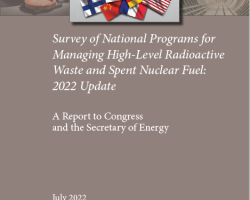Category of Content
Siting Experience Documents Only
Publication Date
Subject Matter
Modeling Coupled THMC Processes and Brine Migration in Salt at High Temperatures
Modeling Coupled THMC Processes and Brine Migration in Salt at High Temperatures
Development of Uncertainty Quantification Methodologies as Applied to Storage and Transportation R&D: Study on Stress Corrosion Cracking of Canister Welds
Development of Uncertainty Quantification Methodologies as Applied to Storage and Transportation R&D: Study on Stress Corrosion Cracking of Canister Welds
Influence of Nuclear Fuel Cycles on Uncertainty of Long-Term Performance of Geologic Disposal Systems
Influence of Nuclear Fuel Cycles on Uncertainty of Long-Term Performance of Geologic Disposal Systems
Model Evaluation of the Thermo-HydrologicalMechanical Response in Argillaceous Sedimentary Rock Repository for Direct Disposal of Dual-Purpose Canisters
Model Evaluation of the Thermo-HydrologicalMechanical Response in Argillaceous Sedimentary Rock Repository for Direct Disposal of Dual-Purpose Canisters
Covariance Data for Used Nuclear Fuel Uncertainty Analysis
Covariance Data for Used Nuclear Fuel Uncertainty Analysis
Experiments and Modeling to Support Field Test Design
Experiments and Modeling to Support Field Test Design
FY18 Progress of EBS International Collaborations
FY18 Progress of EBS International Collaborations
Experiments and Modeling to Support Field Test Design
Experiments and Modeling to Support Field Test Design
Guidance for Creating a Community Benefits Plan for Regional Direct Air Capture Hubs
Guidance for Creating a Community Benefits Plan for Regional Direct Air Capture Hubs
This document is intended to provide supplemental information to assist applicants developing a Community Benefits Plan (CBP) for the Regional Direct Air Capture Hubs. As shown in the graphic to the right, Community Benefits Plans are based on a set of four core interdependent policy priorities: engaging communities and labor; investing in America's workforce; advancing diversity, equity, inclusion, and accessibility; and implementing Justice40.
Policies for Achieving Energy Justice in Society: Best Practices for Applying Solar Energy Technologies to Low-Income Housing
Policies for Achieving Energy Justice in Society: Best Practices for Applying Solar Energy Technologies to Low-Income Housing
Studies indicate that the energy burden — energy costs as a percentage of annual family income — on low-income families is inordinately high, compared to that of the rest of the population. Rising fuel costs exacerbate this problem. Residential solar energy systems can help address this situation by furnishing a price-stable energy source with the added benefit of reduced greenhouse gas emissions. However, without appropriate incentives, these systems are prohibitively expensive for low-income families.
Survey of National Programs for Managing High-Level Radioactive Waste and Spent Nuclear Fuel: 2022 Update
Survey of National Programs for Managing High-Level Radioactive Waste and Spent Nuclear Fuel: 2022 Update
In October 2009, the U.S. Nuclear Waste Technical Review Board (Board or NWTRB) published Survey of National Programs for Managing High-Level Radioactive Waste and Spent Nuclear Fuel. For each of the 13 national programs studied, the report catalogued 15 institutional arrangements that had been set in place and 15 technical approaches that had been taken to design repository systems for the long-term management of high-activity radioactive waste.

